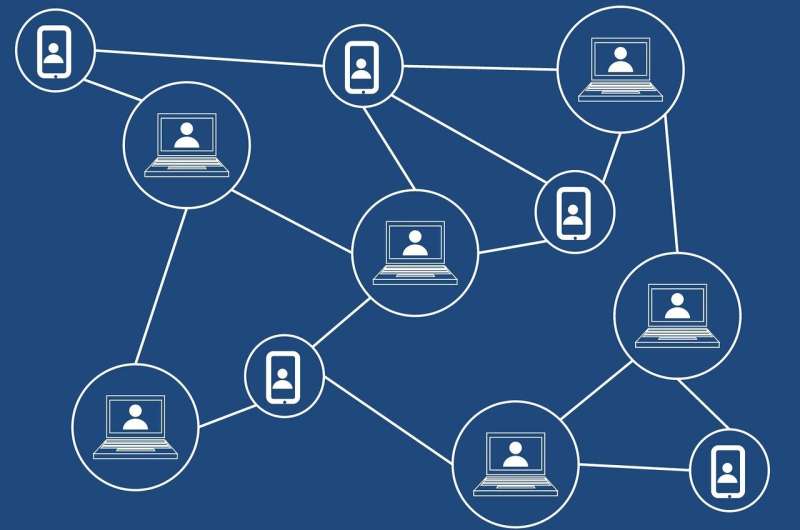This article has been reviewed according to Science X's editorial process and policies. Editors have highlighted the following attributes while ensuring the content's credibility:
fact-checked
trusted source
proofread
Fighting fake news: Research offers solutions through machine learning, blockchain

Time is of the essence as a deluge of updates spreads across the internet and social media feeds. Members of the public are eager to find information they can trust.
False information can lead to harmful consequences. News, social media and government organizations have adopted new strategies in recent years, putting greater emphasis on fact-checking and flagging misleading posts, to provide the important context audiences need.
But how can content creators focus their efforts on areas where the misinformation is likely to do the most public harm? Research from Binghamton University's School of Management (SOM) offers possible solutions through a proposed machine learning framework, as well as expanded use of blockchain technology.
"We're most likely to care about fake news if it causes a harm that impacts readers or audiences. If people perceive there's no harm, they're more likely to share the misinformation," said Thi Tran, assistant professor of management information systems, who led the research. "The harms come from whether audiences act according to claims from the misinformation, or if they refuse the proper action because of it. If we have a systematic way of identifying where misinformation will do the most harm, that will help us know where to focus on mitigation."
Tran recently presented his research at a conference hosted by SPIE, an international non-profit dedicated to advancing light-based research and technologies. One paper focused on the machine learning-based framework, which is a branch of artificial intelligence (AI) and computer science that uses data and algorithms to imitate the way humans learn while gradually improving its accuracy. Another paper dealt with the use of blockchain, which is a type of shared database technology. Both papers are also published as part of Disruptive Technologies in Information Sciences VII.
Tran's research proposed machine learning systems to help determine the scale to which content could cause harm to its audience and zero in on the worst offenders. Examples include stories that circulated during the height of the COVID-19 pandemic touting false alternate treatments as opposed to the vaccine.
The framework would use data and algorithms to spot indicators of misinformation and use those examples to inform and improve the detection process. It would also consider user characteristics from people with prior experience or knowledge about fake news to help piece together a harm index. The index would reflect the severity of possible harm to a person in certain contexts if they were exposed and victimized by the fake news.
Based on the information gathered, Tran said, the machine learning system could help fake news mitigators discern which messages are likely to be most damaging if allowed to spread unchallenged.
"Your educational level or political beliefs, among other things, can play a role in whether you are likely to trust one misinformation message or not and those factors can be learned by the machine learning system," Tran said. "For example, the system can suggest, according to the features of a message and your personality and background and so on, that it's 70% likely that you'll become a victim to that specific misinformation message."
While other studies have been conducted about using blockchain technology as a tool to fight fake news, Tran's research also expands on previous findings by exploring user acceptability of such systems more closely.
"The research model I've built out allows us to test different theories and then prove which is the best way for us to convince people to use something from blockchain to combat misinformation," Tran said.
Tran proposed surveying 1,000 people from among two groups: fake news mitigators (government organizations, news outlets and social network administrators) and content users who could be exposed to fake news messages. The survey would lay out three existing blockchain systems and gauge the participants' willingness to use those systems in different scenarios.
Traceability is one of the nice features of blockchain, Tran said, because it can identify and classify sources of misinformation to help with recognizing the patterns.
"I hope this research helps us educate more people about being aware of the patterns," Tran said, "so they know when to verify something before sharing it and are more alert to mismatches between the headline and the content itself, which would keep the misinformation from spreading unintentionally."
More information: Thi Tran et al, Human-machine interactions in the fake news era: an integrated data analytics and behavioral approach, Disruptive Technologies in Information Sciences VII (2023). DOI: 10.1117/12.2663984
Thi Tran et al, Implementations of blockchain applications to fight fake news: an applicability and acceptance investigation framework, Disruptive Technologies in Information Sciences VII (2023). DOI: 10.1117/12.2663953



















